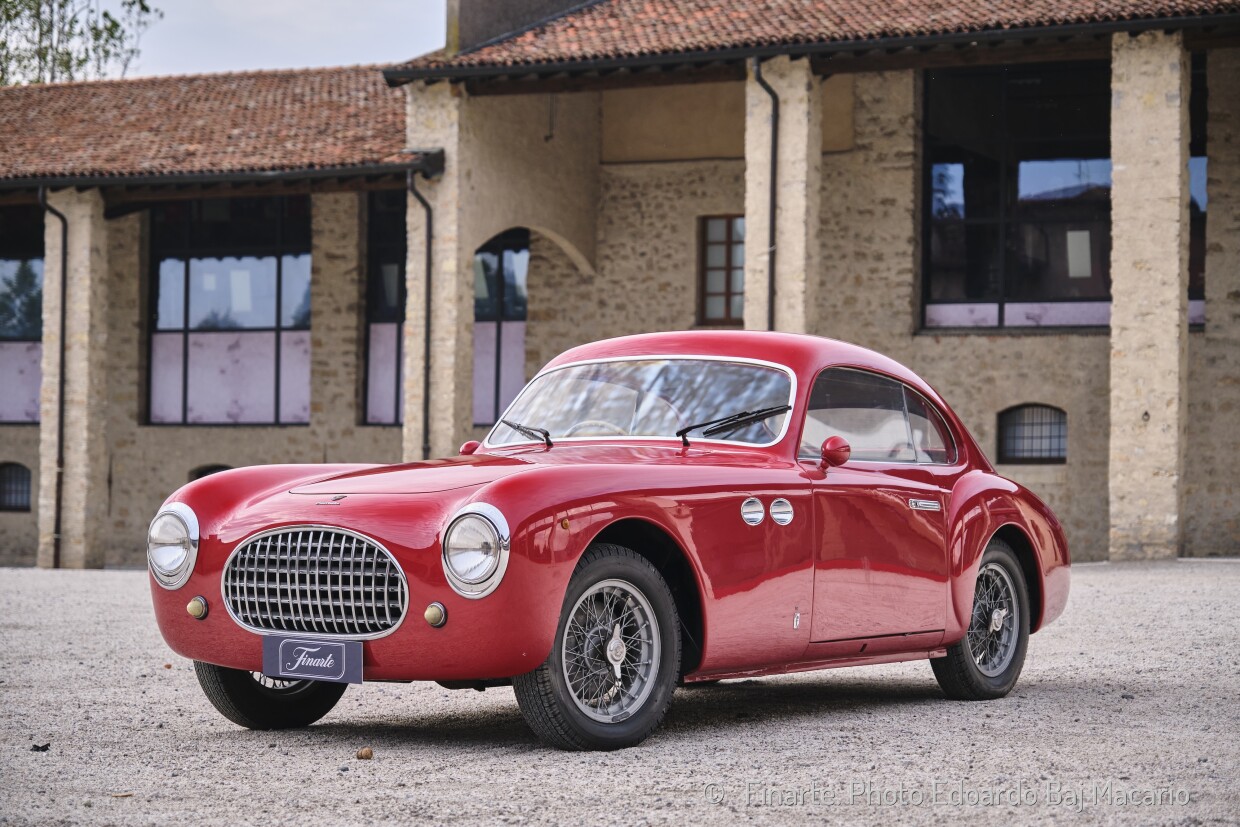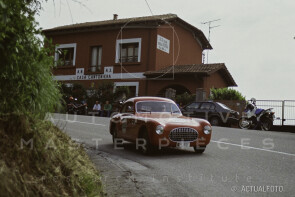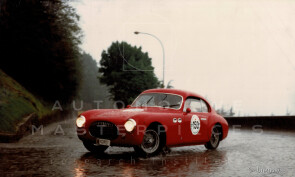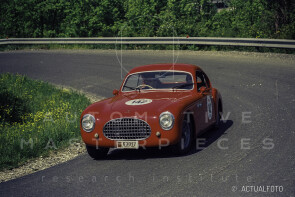
1949 Cisitalia 202 Gran Sport
ON/OFF
Why am I an Automotive Masterpiece?
L. Limited edition cars
no. 153 manufactured
Founded in 1939 by Turinese texile industrialist Piero Dusio to manufacture sports equipment, Consorzio Industriale Sportiva Italia (Cisitalia) amassed a fortune for its former soccer star owner making military uniforms during WW2. An experienced amateur driver, Dusio used his fortune to become involved with the sport he loved. After winning his class on the 1937 Mille Miglia, he began to explore the possibilities of building his own racing cars. Cisitalia's first model was the D46 appeared in 1946, a small single seater which used a tubular steel space-frame chassis crafted at Cisitalia’s bicycle factory to support readily-available Fiat mechanicals as Fiat 1090cc engine and Fiat 500 suspension. After fifty D46s were sold and the model archived a debut victory in the Coppa Brezzi in Turin, Cisitalia focused on building small passenger car based on the D46, including its Fiat components and space frame chassis. In the summer of 1946, the 202 CMM (Coupé Mille Miglia) was initially designed by Dante Giacosa and continued by Giovanni Savonuzzi (hired by Dusio in August 1945). The first coupé was built by Alfredo Vignale, at the time the departmental head of Stabilimenti Farina and allowed him to set up his own carrozzeria. The Cisitalia 202 SMM (Spyder Mille Miglia) was derived directly from the coupé. After Nuvolari epic effort, subsequent competition spiders were known as 202 SMM Nuvolaris. Savonuzzi’s design, was submitted to Battista Pinin Farina as an initial concept for the new coupé 202 Gran Sport and inspired the master to create one of the most significant examples of body styling in automotive history. Cisitalia provided Pinin Farina with the chassis on which the Cisitalia's body was placed. The body was more or less handcrafted, with its aluminum panels shaped over wooden forms. Its shapes are the finishing point of all the previous research: the hood, body, fenders, and headlights are integral to the continuously flowing surface, rather than added on, creating a general sense of beaty and speed. Unveiled in 1947 at the exhibition of Coachbuilders at the Milan Triennale and Paris Motor Show, it won the Coppa d’Oro prize at the Villa d’Este Concours d’Elegance. The Cisitalia 202 Gran Sport was defined as “a rolling sculpture” in 1951 when it was chosen, along with seven other cars, for an exhibition at the Museum of Modern Art in New York (MoMA). The 202 is the progenitor of all modern sports cars stands as a timeless bridge between pre- and post-war sports car design. Its lines had a strong impact on the aesthetics of car design at the time, breaking with tradition and introducing new concepts in style. Coupé versions of the 202 were the first produced. A cabriolet followed. The 202 were built around low-cost Fiat components including a redesigning chassis and a 1089cc four-cylinder engine delivering 66 horsepower. The first Gran Sport model has only two seats and is the first car in history to have the brand name even in the back. The first development, the 202 Berlinetta - or B - can instead accommodate four people (three in front and one, bad, behind) and is distinguished by its more massive grille and chrome bumpers. The 1951 202 C has the the trunk accessible from outside and the rear window wider. The early 202 grill was aluminum and had 23 individual teeth shaped like a "D" with the curved part facing forward, and a narrow surround. The later 202 had a chrome plated grill with 18 thicker teeth and a thicker surround. The twin windscreen was later replaced with a one-piece curved windscreen. The 202 body production by Pinin Farina soon shifted over to Stabilimenti Farina and, to a lesser extent, Vignale. Both built the 202 to Battista Pinin Farina's original design, although there are some differences. It was expensive, and only 170 were produced between 1947 and 1952, 153 coupes and 17 cabriolets.
This specimen, with chassis no. 120 SC, is a first series Gran Sport, but already with elements from the second series, such as the windshield in one piece. It has in fact been ascertained that, from the number 110, other cars were assembled with material from both models. Furthermore, it is known that some chassis numbers were built without following the numbering attributed to them, most likely because they were assembled by Stabilimenti Farina e Vignale, on specific requests from the customers themselves. Even the attribution of the bodywork is not simple: some sources claim that, from chassis n° 100, they would all have been assembled by Stabilimenti Farina and Vignale but the fact that the chassis may have been bodyworked out of order does not help to clarify the question. Certainly, the full windshield appears in the last models of the first series, but also in the example n. 100 and, therefore, prior to split-window specimens. From research, it seems that Stabilimenti Farina was the first to adopt the full windscreen, while Vignale was the first to adopt the side vents, then taken up by Stabilimenti Farina and introduced, with subsequent modification, on Pinin Farina cars. The car has been validated as a Pinin Farina specimen by the ASI and FIVA commissions; however, the car is still being researched and the attribution is still under study. Assembled in 1949, the history of this car is still shrouded in mystery, it seems that after a start in Italy its history has passed for many years in Uruguay. An old hypothesys was that it could have been imported by Dusio himself in the early 1950s. More recently, it was ascertained that the car must have been part of a batch of 6 Cisitalias imported into Uruguay in 1950 by the importer Emilio Fontana, a friend of Dusio. The chassis, which should be three coupes and three cabriolets, turn out to be: 118 SC, 120 SC, 126 SC, 128 SC, 141 SC, 148 SC. Found in Uruguay, the car returned to Italy in the mid-1980s. The car was imported complete but with the wrong headlights, without grille and with the rear modified. It retains the original Uruguay number plate for display only but has been registered in Italy since 1993 with the “ZA” plate. It was restored with the assistance of the expert Emilio Comelli in 1986-1987. In the first instance, the sheet metal worker from Turin, Casella, was also involved. However, the car was later finished by Borgogna in Brescia, which coordinated the work and did the assembly. The painting was the work of Carrozzeria Pipers in Brescia, and the mechanics were taken care of by the well-known mechanic and specialist Gabriele Terzi of Treviglio. 120 SC has been in the same collection for almost forty years from 1980s. The car then had an intense life in re-enactments for historic cars; it took part in the Mille Miglia 1988, 1989, 1990, 1991, 1992. It won the first place overall at the Mille Miglia 1990. It was also present in other races such as the Coppa delle Alpi.




